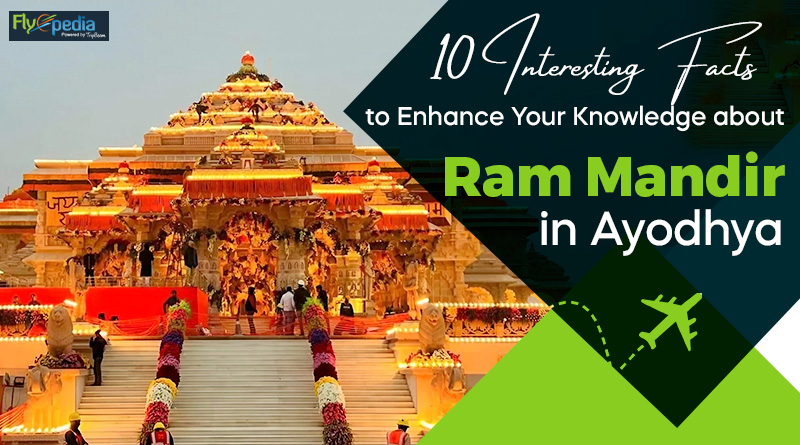10 Interesting Facts to Enhance Your Knowledge About Ram Mandir in Ayodhya
On January 16th, preparations for the opening of the Ram Temple in Ayodhya began. The Grand Temple is set to host this significant occasion on January 22nd. The general secretary of the Shri Ram Janmabhoomi Teerth Kshetra Trust, Champat Rai, confirmed that the public could get darshan at the Ram temple from January 23 onwards.
The entire country has a fascination with Lord Ram. The vastness of Lord Ram’s life, inspiration, and faith goes well beyond devotion. Lord Ram represents good administration in social life. Ayodhya’s security for the Ram temple dedication is robust, with night vision and AI-enabled CCTV cameras. The shrine is overflowing with flowers and brilliant lights. Additionally, You can plan your visit to the Historical Ram Mandir in Ayodhya. Book your cheap flight tickets to India from USA today and have an extraordinary spiritual experience. Don’t miss out on this incredible opportunity. Consider Flyopedia.com to book tickets instantly! As Ayodhya prepares for the big opening of Ram Mandir on January 22,
Essential temple facts you should know:
1. The Largest Temple in India
The Ram Mandir, expected to be inaugurated soon, is set to become India’s largest temple based on its architectural framework. The Sompura family, who designed the temple, stated that the architectural blueprints were created 30 years ago by Ashish Sompura, Chandrakant Sompura’s son. According to the family, the temple will tower roughly 161 feet tall and span a large area of 28,000 square feet. Explore the heart and soul of this holy place by booking Direct flights to Delhi from USA with Flyopedia.com, a trust flight ticket booking platform.
2. The Sanctified base
The Ram Mandir was built with soil from 2587 sacred places, making it a profoundly spiritual monument. Jhansi, Bithoori, Haldighati, Yamunotri, Chittorgarh, the Golden Temple, and many more hallowed sites were among the most recognized.
3. The Architects are Sompura family:
They are supposed to be members of the legendary Sompura family, which has erected over 100 temples around the world, including the sacred Somnath Temple. Led by chief architect Chandrakant Sompura and his sons Ashish and Nikhil, they have left a legacy in temple architecture that will last for decades.
4. Completely built of stones, No iron or steel used
The Ram Mandir in Ayodhya is built without the use of iron or steel, making it a unique structure. Instead, the project incorporates conventional construction materials, adhering to centuries-old building traditions and showing a dedication to ecology.
5. The Sacred inscription ‘Shree Ram’ on Bricks
It is worth noting that the bricks used to create the Ram Mandir have the sacred inscription ‘Shri Ram.’ This recalls a historic process used in the construction of Ram Setu, promising increased strength and longevity for the current version of these bricks.
6. Thailand’s soil
As a demonstration of global spiritual solidarity, supporters sent soil from Thailand for the consecration ceremony of Ram Lalla on January 22, 2024. This serves to further emphasise how Lord Ram’s legacy is resonant everywhere, regardless of geographic location.
Meanwhile, if you’re browsing for Canada to India flight tickets, simply go on to Flyopedia.ca, it provides various offers on Canada to India flight tickets.
7. The Temple has the following unique features
The ground floor depicts Lord Ram’s life, while the first floor immerses visitors in the grandeur of Lord Ram’s Darbar, constructed from Bansi Paharpur, a pink sandstone from Rajasthan’s Bharatpur. This temple measures 360 feet long, 235 feet wide, and reaches a height of 161 feet, including the summit. With three storeys and twelve gates, it is a spectacular example of architectural magnificence.
8. 150 Holy River Water used in the Foundation
On August 5th, a specific sacred water used to lay the foundation. This mystical water came from 150 holy rivers across India. Two brothers, Shabd Vaigyanik Mahakavi Triphala and Radhey Shyam Pandey, gathered this water. The blend contains water from three seas, eight rivers, and soil from Sri Lanka. This combination of holy water includes water from Mansarovar, a 600-year-old Durga Temple in the West Jaintia Hills, and the rivers Myntang and Myntdu.
9. Time capsule for the future
A time capsule buried 2000 feet beneath the temple will include a copper plate imprinted with pertinent facts about the temple, Lord Ram, and Ayodhya, preserving the temple’s heritage for future generations.
10. Architecture in the Nagar Style
The temple has 360 Nagar-style pillars, which add to its visual attractiveness and make it an architectural wonder.
Concluding Statement:
So, Pack your bags and book your last minute flight tickets to India. Explore the appealing Ram Mandir in Ayodhya. Don’t miss out on this opportunity to witness the cultural richness and divine beauty. Reserve your tickets with Flyopedia for an extraordinary experience.
Also Read: 7 Incredible Indian Destinations to Discover Hindu Mythology




